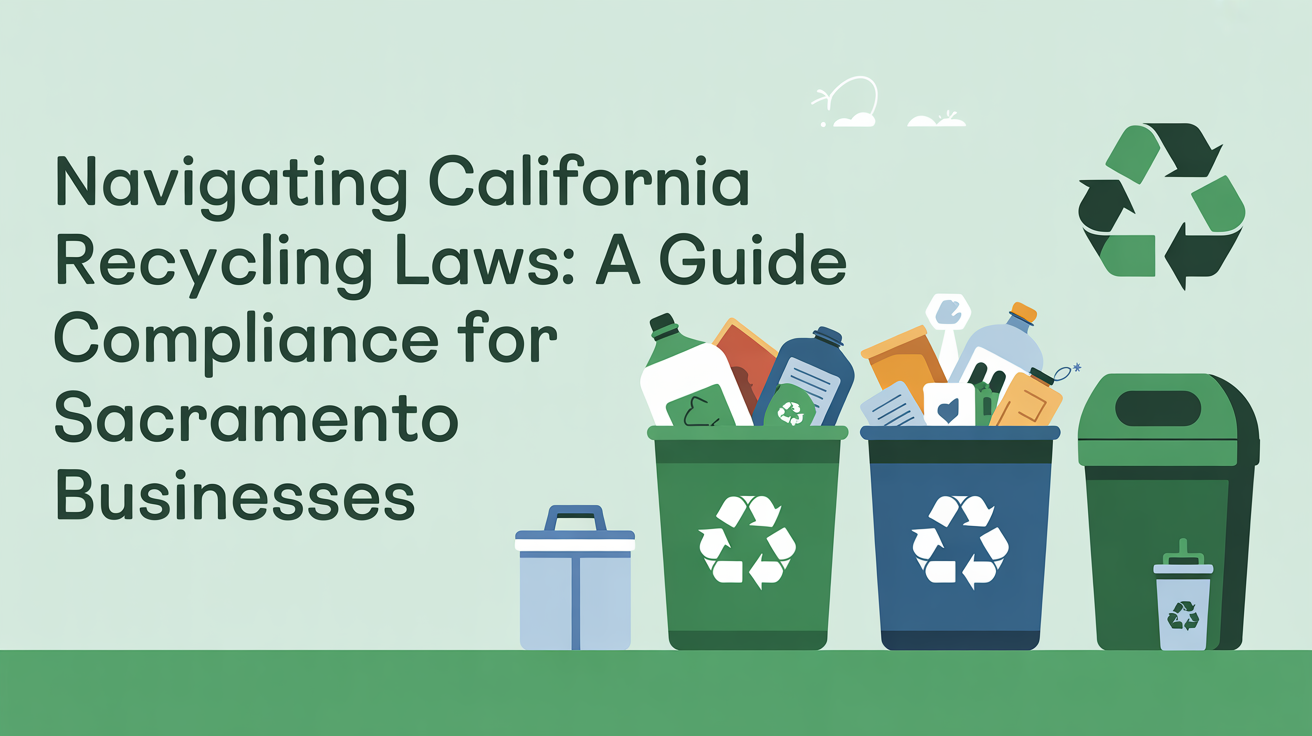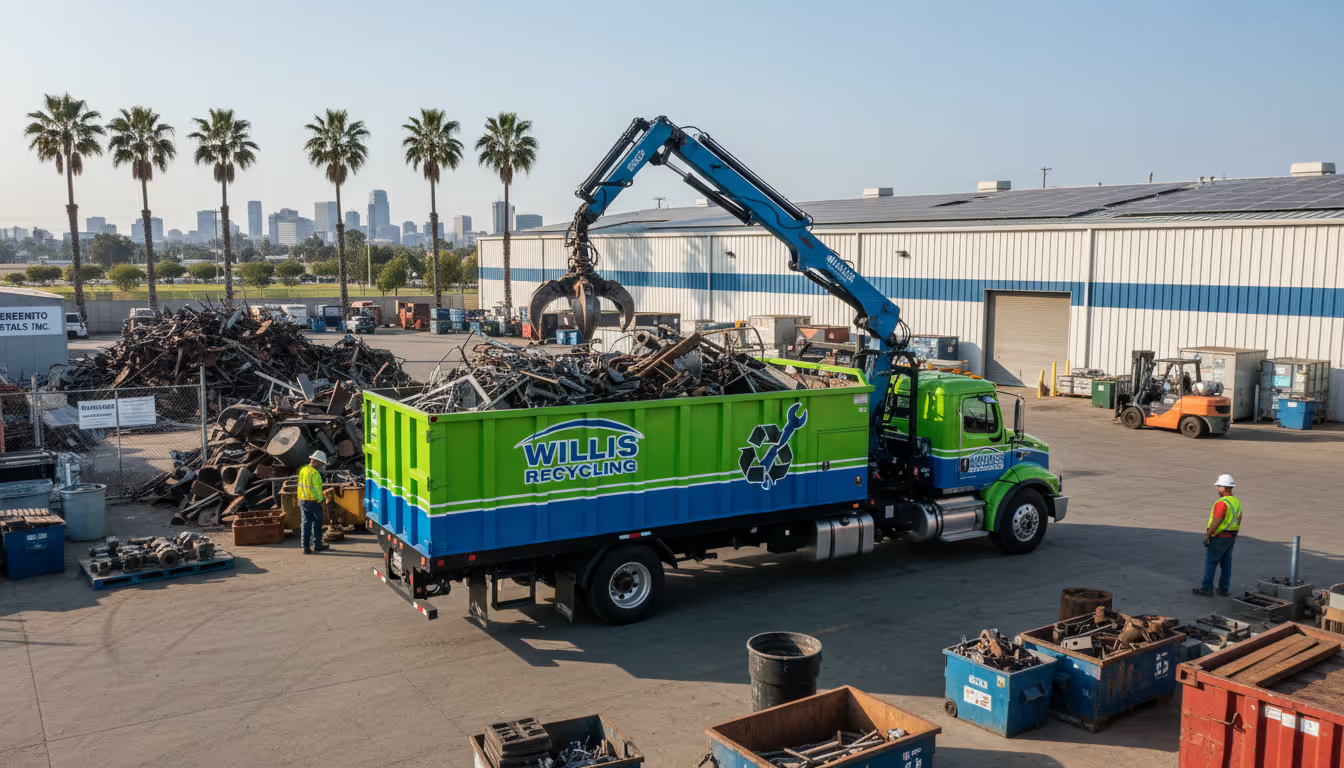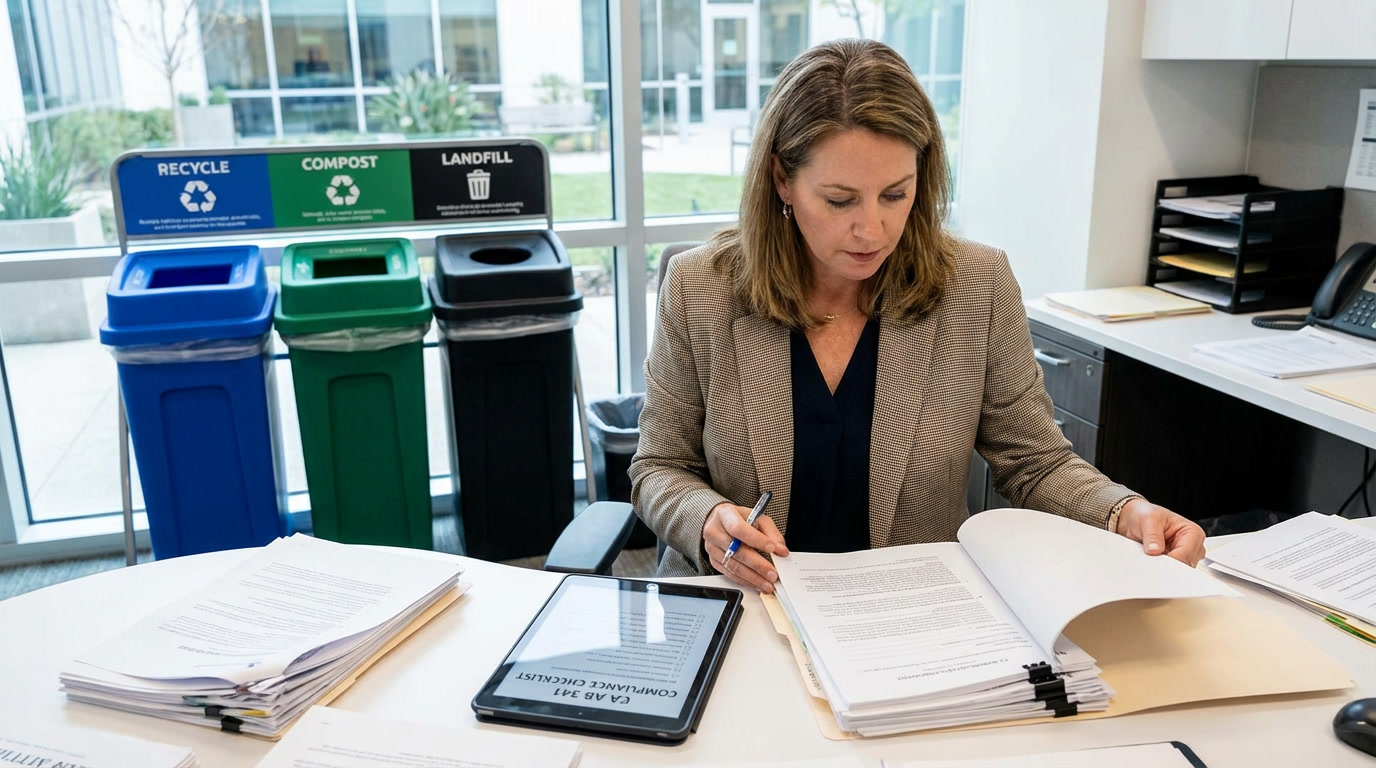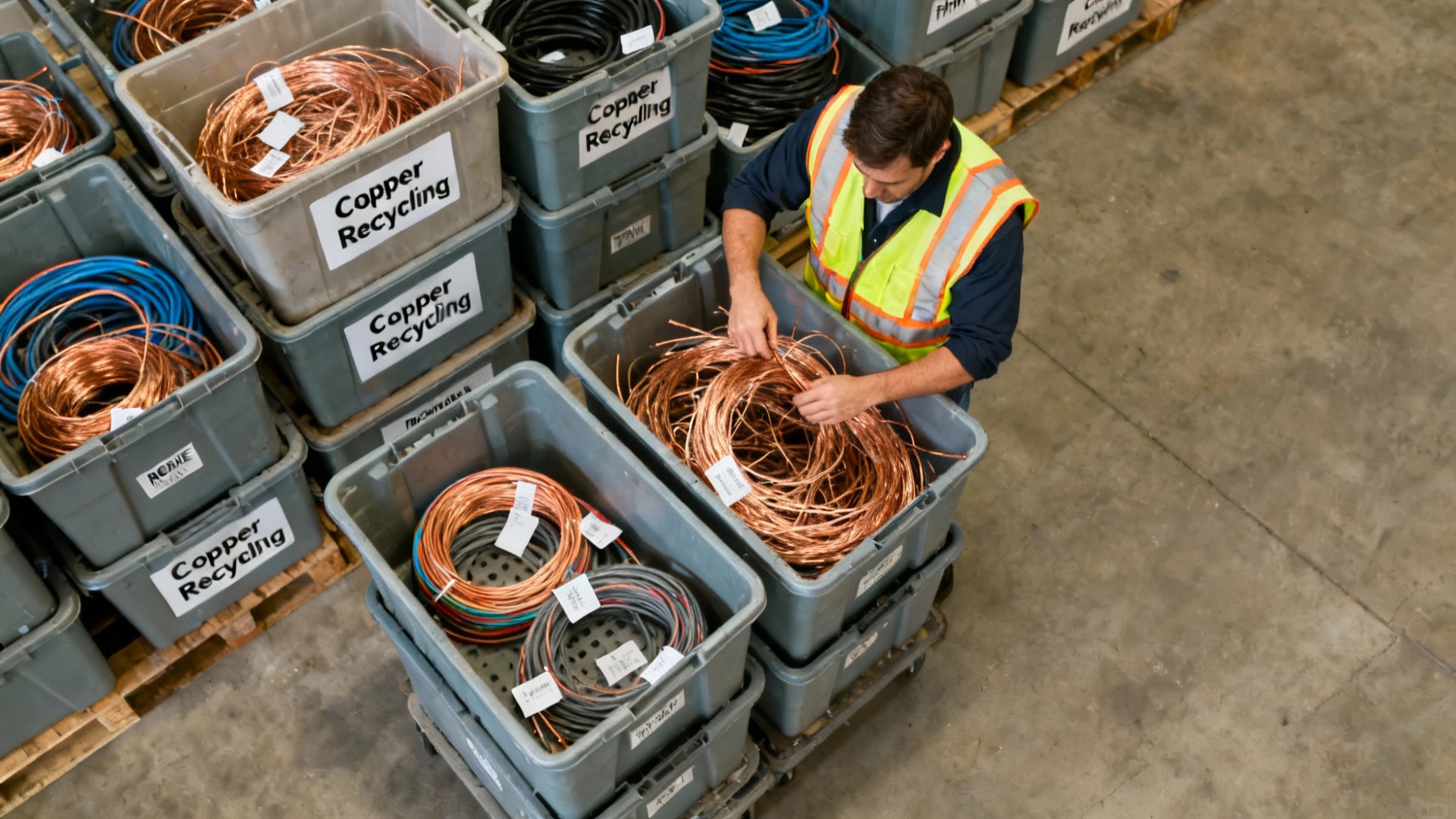A Compliance Guide for Sacramento Businesses
Introduction
Running a business in Sacramento means following California recycling laws. These rules change often. Missing them costs money.
Let's make compliance simple. This guide breaks down exactly what your Sacramento business needs to do. We'll skip the legal jargon and focus on practical steps.
Why Sacramento Businesses Can't Ignore California Recycling Laws
California leads the nation in environmental regulations. Sacramento County adds its own rules too. Together, they create a complex system.
Here's what's at stake:
Daily fines up to $500
Surprise inspections
Business license problems
Angry customers who care about sustainability
The good news? Compliance is manageable when you know the rules.
Understanding California's Core Recycling Law (AB 341)
Since 2012, AB 341 has set the foundation. It's surprisingly straightforward.
Your business must recycle if you:
Generate 4+ cubic yards of waste weekly
Own a multi-family building with 5+ units
Run any state or local facility
CalRecycle explains AB 341 requirements in detail [1].
Think about it this way. A standard dumpster holds 3 cubic yards. If you fill it twice weekly, you're covered by this law.
What counts as 4 cubic yards?
One 4-yard dumpster picked up weekly
Two 2-yard bins collected weekly
A 3-yard container emptied twice weekly
Most Sacramento businesses hit this threshold. Even small restaurants and offices often qualify.
SB 1383: The Food Waste Game-Changer
This newer law hits Sacramento businesses hard. Since January 2022, organic waste needs special handling.
SB 1383 covers:
All food scraps
Food-soiled paper
Yard trimmings
Untreated wood
The threshold is lower too. Just 2 cubic yards of total waste triggers this requirement.
Learn more about SB 1383 from CalRecycle [2].
Sacramento restaurants feel this most. A typical Midtown Sacramento restaurant generates 20-30 yards of waste weekly. About 60% is organic material.
Sacramento-Specific Requirements You Need to Know
Sacramento County enforces state laws strictly. They also add local touches.
Downtown Sacramento Core The Downtown Sacramento Partnership encourages businesses to exceed minimum standards. They offer recognition programs for green businesses.
Sacramento County Unincorporated Areas These zones follow county-specific ordinances. Check if you're in Carmichael, Fair Oaks, or Orangevale. Each has slight variations.
City of Sacramento Proper The city runs regular compliance checks. They focus on:
Old Sacramento businesses (high tourist visibility)
Richards Boulevard industrial corridor
Power Inn Road commercial district
Natomas business parks
Visit Sacramento County's recycling page for local rules [3].
Your Simple 3-Step Compliance Process
Step 1: Conduct Your Waste Audit (Week 1)
Start next Monday. It's easier than you think.
Monday Morning:
Photograph your dumpster before pickup
Note how full it is (25%, 50%, 75%, full?)
Check for recyclables thrown in trash
Throughout the Week:
Track what your business throws away
Separate one day's waste into categories
Weigh each category if possible
Friday Afternoon:
Calculate your weekly waste total
Identify your biggest waste sources
Spot recycling opportunities
Many Sacramento businesses discover surprising things. A Roseville tech company found 40% of their waste was recyclable paper. They'd been throwing it all away.
Step 2: Set Up Your Recycling System (Week 2-3)
Now you know what you're throwing away. Time to fix it.
Choose the Right Bins:
Blue for recyclables
Green for organics (if required)
Gray or black for trash
Size them based on your audit. Don't guess.
Strategic Placement Matters:
Kitchen areas need organic bins
Offices need paper recycling
Break rooms need all three types
Loading docks need cardboard collection
Clear Signage is Critical: Create signs with pictures. Words aren't enough.
Include these languages for Sacramento:
English
Spanish
Mandarin
Vietnamese
A Natomas distribution center reduced contamination 70% with picture-based signs.
Partner Selection: Choose haulers familiar with Sacramento regulations. Find certified haulers on CalRecycle's database [4].
Ask potential partners:
Do you provide compliance documentation?
Can you handle both recycling and organics?
What training do you offer?
How do you track diversion rates?
Step 3: Document and Train (Ongoing)
Compliance isn't a one-time event. It needs constant attention.
Essential Documentation:
Hauler service agreements
Monthly weight tickets
Training attendance sheets
Waste audit reports
Contamination incident logs
Keep everything for five years. Inspectors will ask.
Employee Training Schedule:
New hire orientation (Day 1)
Quarterly refreshers (15 minutes)
Annual deep dive (1 hour)
Contamination alerts (as needed)
Make training practical. Show actual examples from your bins.
A Sacramento hotel chain reduced contamination 85% using photos of their own mistakes in training.
Real Sacramento Business Compliance Examples
Case 1: Midtown Restaurant Giuseppe's Italian Kitchen on J Street generates 6 cubic yards weekly. They implemented:
Separate organics collection for kitchen prep
Customer-facing recycling in dining areas
Staff training in Italian and Spanish
Weekly contamination checks
Result: 65% waste diversion and zero violations.
Case 2: Natomas Office Complex A 50,000 square foot office building near Arena Boulevard handles:
30+ tenants with different needs
Central recycling room
Tenant education programs
Monthly compliance reports to each business
They avoided $15,000 in potential fines last year.
Case 3: South Sacramento Warehouse A Florin Road distribution center processes:
500 pounds of cardboard daily
Mixed paper from offices
Plastic shrink wrap
Wooden pallets
They installed a baler and now earn $500 monthly from cardboard sales.
Industry-Specific Compliance Strategies
Sacramento Restaurants and Food Service
Restaurants face the toughest requirements. Food waste is heavy and problematic.
Kitchen Protocols:
Pre-consumer prep waste goes straight to organics
Post-consumer plate waste needs separate handling
Grease requires special recycling (not in organics)
Cardboard must stay dry and clean
Front-of-House Systems:
Customer bins need constant monitoring
Liquid must drain before disposal
Napkins go to organics (they're compostable)
Plastic cups need rinsing for recycling
Popular Sacramento restaurants like Mulvaney's B&L excel at this. They train servers to sort customer waste properly.
Sacramento Office Buildings
Offices generate mostly paper and e-waste.
Desk-Side Success:
Provide small recycling bins at each desk
Central collection stations per floor
Locked bins for confidential paper
Quarterly e-waste collection events
The State Capitol complex diverts 75% of office waste. Your building can too.
Common Office Mistakes:
Coffee cups in paper recycling (they're lined with plastic)
Shredded paper loose in bins (bag it first)
Food waste in desk bins (attracts pests)
Batteries in regular trash (hazardous waste)
Sacramento Retail Locations
Retail creates predictable waste streams.
Cardboard Management:
Flatten all boxes immediately
Keep cardboard dry
Consider a baler for high volume
Schedule pickups to avoid overflow
Arden Fair Mall retailers share a cardboard compactor. This cooperation saves money.
Customer-Facing Recycling:
Place bins near exits
Use clear, simple labels
Empty frequently during peak times
Train security to monitor contamination
Sacramento Medical Facilities
Healthcare has unique challenges. Medical waste needs special handling.
Safe Recycling Areas:
Administrative offices (standard recycling)
Cafeterias (organics and recycling)
Waiting rooms (limited recycling)
Never in patient care areas
UC Davis Medical Center leads Sacramento healthcare in recycling. They divert 45% of non-medical waste.
Common Compliance Mistakes and Solutions
Mistake 1: Contamination
The Problem: One pizza box ruins a recycling bin. Liquids destroy cardboard value.
The Solution:
Train staff weekly on problem items
Post photos of actual contamination
Reward teams with clean bins
Do spot checks during shifts
Mistake 2: Wrong Bin Sizes
The Problem: Overflowing bins lead to illegal dumping. Oversized bins waste money.
The Solution:
Audit quarterly to adjust sizes
Track fullness before each pickup
Negotiate flexible sizing with haulers
Consider compactors for high volume
Mistake 3: Poor Documentation
The Problem: Missing paperwork means failed inspections. Inspectors need proof.
The Solution:
Create a compliance binder
Scan everything digitally
Set calendar reminders for reports
Assign one person to manage records
Mistake 4: Untrained New Employees
The Problem: New staff contaminate bins. Turnover destroys compliance efforts.
The Solution:
Add recycling to onboarding checklists
Pair new employees with trained staff
Create a simple training video
Test knowledge after training
Advanced Compliance Strategies
Building a Sustainability Culture
Compliance works better with buy-in. Make recycling part of company culture.
Employee Engagement Ideas:
Monthly recycling champions
Team competitions between departments
Share success metrics publicly
Celebrate milestones together
A Sacramento credit union reduced waste 50% through employee competitions. Prize? Prime parking spots.
Technology Solutions
Modern tools simplify compliance.
Useful Technologies:
Smart bins that alert when full
Apps for employee training
Digital tracking of weights
Automated compliance reporting
These cost more upfront but save labor long-term.
Cost Reduction Through Compliance
Good recycling actually saves money.
Financial Benefits:
Smaller trash bins cost less
Recycling pickup is often cheaper
Cardboard baling generates revenue
Avoiding fines saves thousands
Calculate your current waste costs. Then compare with optimized recycling. Most businesses save 20-30%.
Preparing for Future Regulations
California keeps raising standards. Smart businesses prepare early.
Coming Changes:
Extended producer responsibility laws
Stricter contamination standards
Lower thresholds for compliance
Mandatory composting expansion
Check CalRecycle's pending legislation page regularly [5].
Build systems that can adapt. Today's voluntary programs become tomorrow's requirements.
Sacramento Resources and Support for Staying Compliant with California Recycling Laws
You're not alone in this journey.
Local Help:
Sacramento County Environmental Management
SMUD energy and waste programs
Sacramento Metro Chamber green business network
Valley Vision sustainability initiatives
State Resources:
CalRecycle grants and rebates
California Green Business Network
Industry-specific associations
Free waste audit tools online
Private Support:
Waste management consultants
Recycling equipment vendors
Training companies
Compliance software providers
Making It Happen: Your Action Plan
Starting feels overwhelming. Break it into small steps.
Week 1:
Schedule your waste audit
Download tracking sheets
Identify your waste hauler contact
Review your current contracts
Week 2:
Conduct the audit
Analyze results
Identify immediate fixes
Get bin quotes
Week 3:
Order new equipment
Create signage
Schedule employee training
Set up documentation systems
Month 2:
Launch new program
Monitor daily for issues
Adjust bin sizes if needed
Celebrate early wins
Ongoing:
Monthly contamination checks
Quarterly program reviews
Annual comprehensive audits
Continuous improvement
Special Considerations for Small Sacramento Businesses
Small businesses often struggle most. Resources are limited.
Smart Solutions for Small Operations:
Share bins with neighbors
Join business improvement districts
Use free CalRecycle resources
Start with basics, expand gradually
A group of Old Sacramento boutiques shares recycling services. This cut costs 40%.
Minimum Viable Compliance:
Get one recycling bin
Train your five key employees
Keep basic records
Add organics when ready
Perfect is the enemy of good. Start somewhere.
The Bottom Line When it Comes to Navigating California Recycling Laws
Sacramento businesses must comply with recycling laws. Period.
But compliance doesn't mean complexity. Follow the steps here. Use local resources. Ask for help when needed.
Start with a waste audit this week. Build from there. Within a month, you'll have a working system.
Remember: Every Sacramento business can do this. From food trucks to Fortune 500 offices. Size doesn't matter. Commitment does.
Ready to ensure your Sacramento business stays compliant? Willis Recycling offers free compliance consultations. We know Sacramento's unique requirements. We'll design a program that works for your specific situation. Contact us today to schedule your assessment.
Works Cited
[1] CalRecycle — "Mandatory Commercial Recycling." https://calrecycle.ca.gov/recycle/commercial/. Published: 2023-07-15. Accessed: 2025-09-03.
[2] CalRecycle — "SB 1383 Organic Waste Recycling Requirements." https://calrecycle.ca.gov/organics/slcp/. Published: 2024-01-10. Accessed: 2025-09-03.
[3] Sacramento County — "Business Recycling Requirements." https://www.saccounty.gov/services/recycling-waste. Published: 2024-06-20. Accessed: 2025-09-03.
[4] CalRecycle — "Facilities Directory." https://www2.calrecycle.ca.gov/FacilitiesDirectory/. Published: 2024-08-01. Accessed: 2025-09-03.[5] CalRecycle — "Laws and Legislation." https://calrecycle.ca.gov/laws/legislation/. Published: 2024-09-15. Accessed: 2025-09-03.



